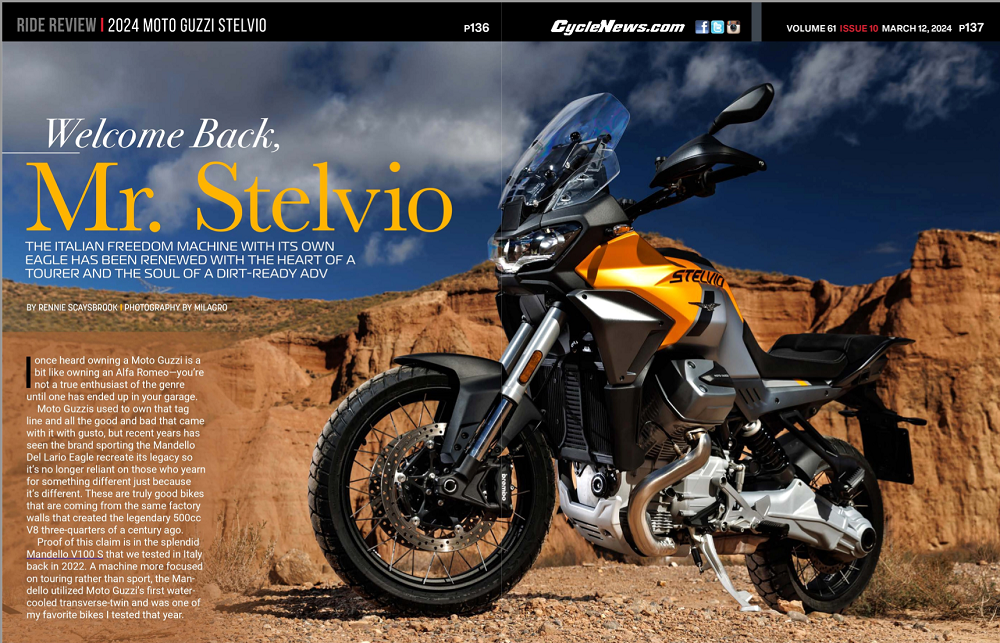Rennie Scaysbrook | March 13, 2024
I once heard owning a Moto Guzzi is a bit like owning an Alfa Romeo—you’re not a true enthusiast of the genre until one has ended up in your garage.
Moto Guzzis used to own that tag line and all the good and bad that came with it with gusto, but recent years has seen the brand sporting the Mandello Del Lario Eagle recreate its legacy so it’s no longer reliant on those who yearn for something different just because it’s different. These are truly good bikes that are coming from the same factory walls that created the legendary 500cc V8 three-quarters of a century ago.
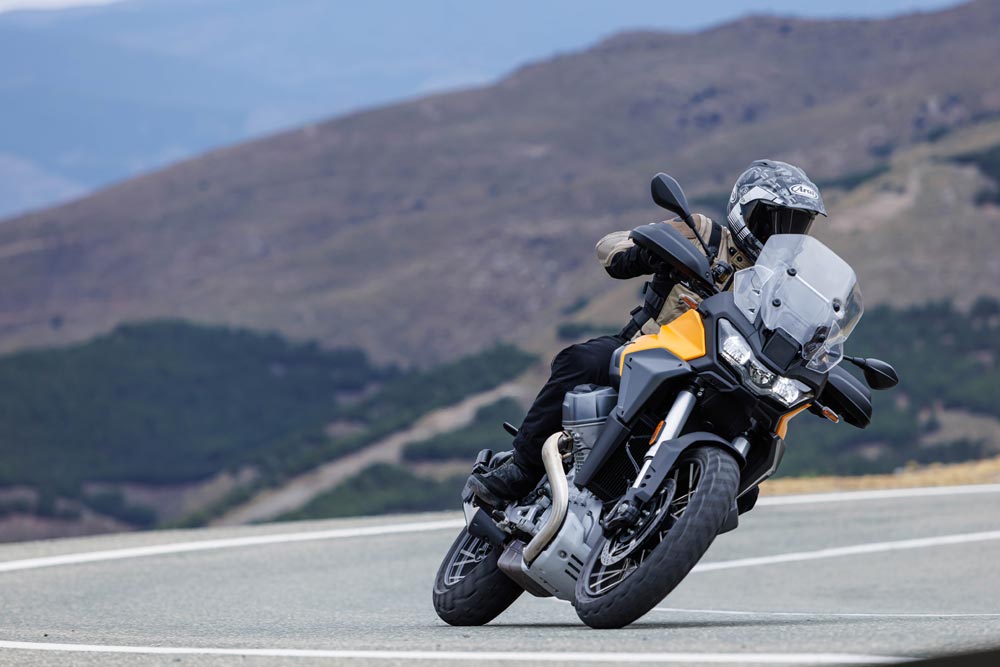 This is the most un-Moto Guzzi Moto Guzzi ever. The Stelvio is a genuine surprise.
This is the most un-Moto Guzzi Moto Guzzi ever. The Stelvio is a genuine surprise.
Proof of this claim is in the splendid Mandello V100 S that we tested in Italy back in 2022: A machine more focused on touring rather than sport, the Mandello utilized Moto Guzzi’s first water-cooled transverse-twin and was one of my favorite bikes I tested that year.
Fast forward two years and we now have the second machine to use the new 90° short block V-twin in the revamped, re-engineered, and thoroughly renewed Moto Guzzi Stelvio.
The Stelvio is Moto Guzzi’s quasi-ADV bike, although to call it a true adventure machine would be doing others in the category a disservice. The Stelvio is more a bike that can go most places, rather than anywhere like a KTM 890 Adventure R, or a Yamaha Tenere, or even Piaggio’s own Aprilia Tuareg.
Dropped from the lineup in 2017 after a 10-year run that saw Moto Guzzi try (and fail) to encroach on BMW’s GS family, the Stelvio’s new aim is primarily paved roads—good and bad condition—and the odd dirt pathway. A bit like its namesake, the iconic Stelvio Pass in Northern Italy.
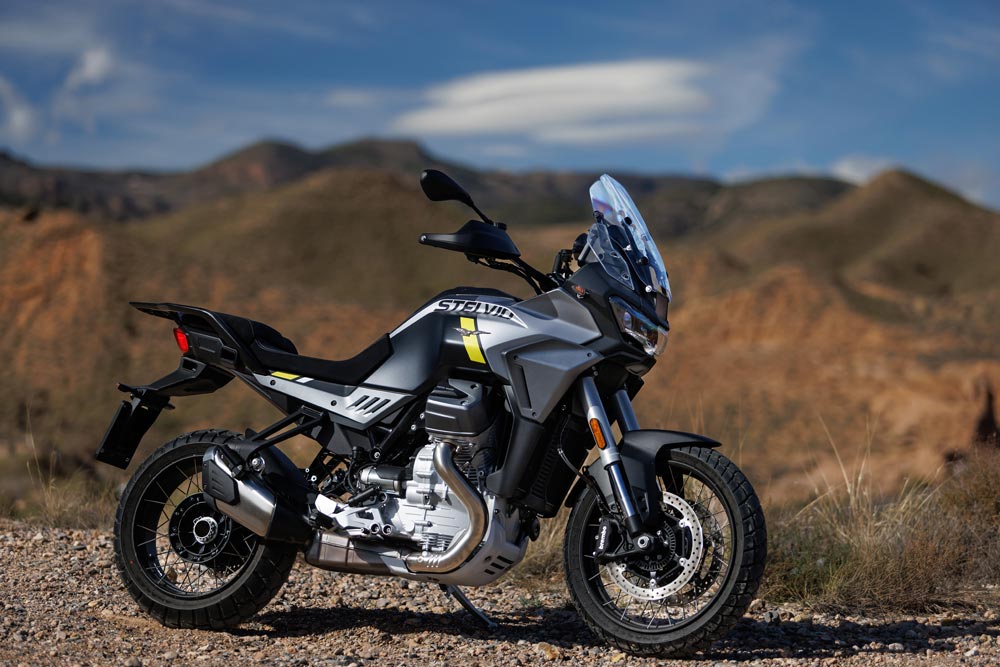 The rather handsome Stelvio’s base package is a tad sparse, and you’ll need to start optioning up if you really want to enhance the ride.
The rather handsome Stelvio’s base package is a tad sparse, and you’ll need to start optioning up if you really want to enhance the ride.
The Mandello V100 and the Stelvio were developed together but there’s a few obvious differences between the two, such as the 19-inch front wheel, higher handlebar position, taller windscreen and the lack of winglets the Mandello featured.
You still get the beautiful 1042cc transverse-mounted V-twin that pumps a claimed 115 hp and 71 lb-ft of torque, which puts it right around the Ducati Multistrada V2 and Triumph Tiger 900 range. Said power is pushing a claimed wet weight of 542 pounds via the only shaft drive in this class category (the BMW R 1300 GS is the next category above).
Performance from the V-twin is one of the pleasantly surprising aspects of the Stelvio’s character. It has such a broad spread of power but is just as happy ripping up through the rev ranges and holding gears—it’s very un-Guzzi in how much it likes to rev and just how much go it has when the revs reach above 8000 rpm.
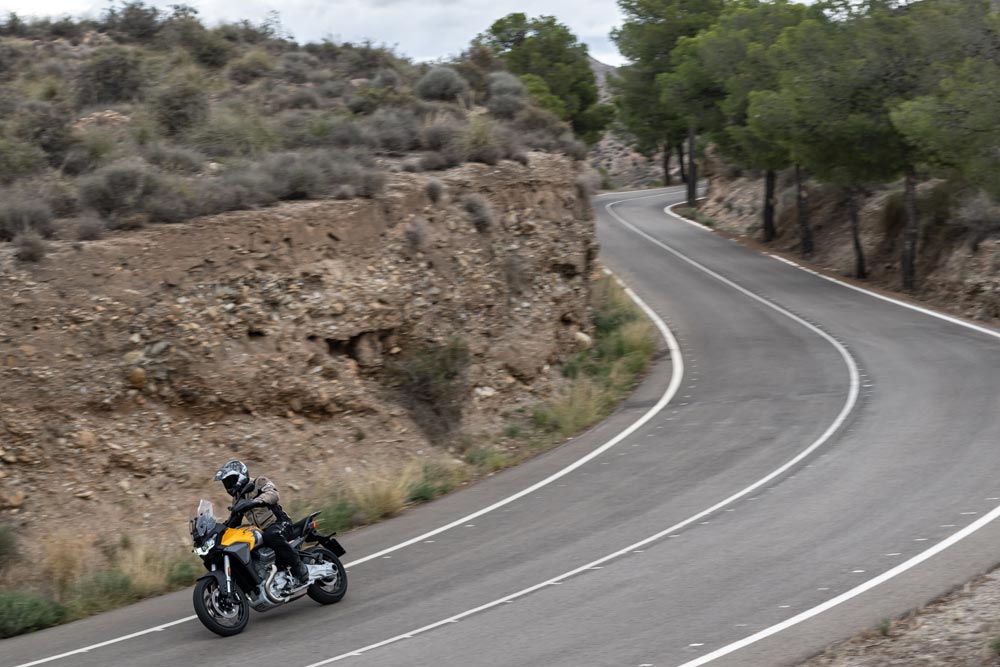 These roads are Stelvio country—lots of medium speed twisties and no particular place to go.
These roads are Stelvio country—lots of medium speed twisties and no particular place to go.
The initial throttle response is metered by five riding modes—Tour, Rain, Road, Sport and Off-Road—although each riding mode retains the 115 maximum horsepower figure. All modes are changed via the five-inch TFT display, and you get the same switch gear as you do on bikes like the Aprilia RS660 and Tuareg, so they feel a little plasticky compared to some of the competition.
Each mode has a reassuringly smooth feel at the twist grip from closed, and there’s still that trademark Guzzi side-to-side rock when you pull the clutch in and give it a rev. However, there’s nowhere near as much driveshaft lash that even Guzzis of recent years imparted to their owners—the Stelvio gets the go to the rear tire very nearly fuss- and maintenance-free.
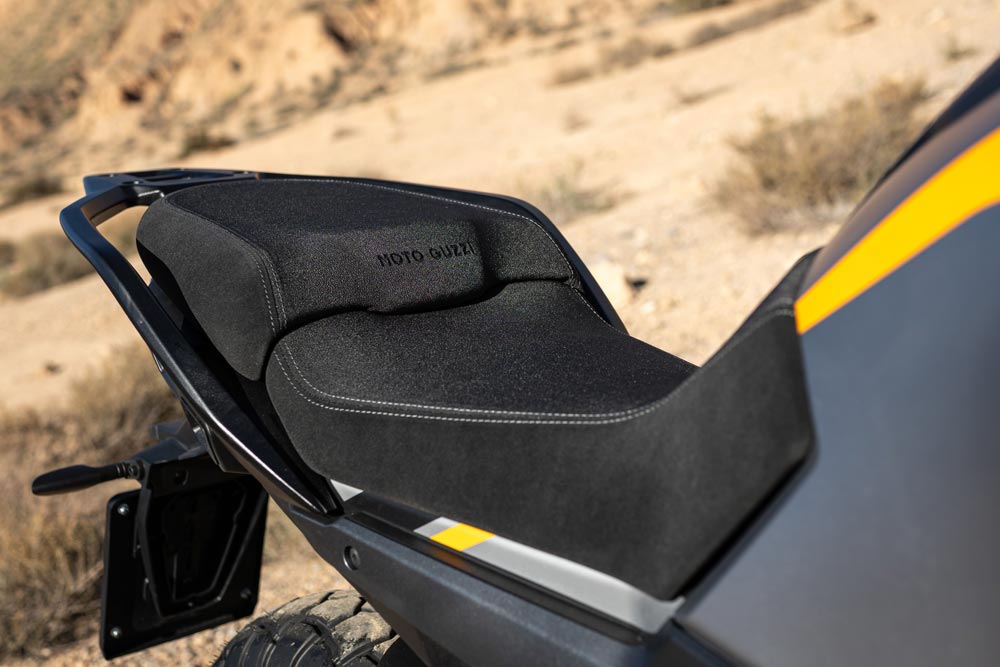 The Moto Guzzi engineers have crafted a very nice seat for a standard piece. It doesn’t get overly hard after four hours on board.
The Moto Guzzi engineers have crafted a very nice seat for a standard piece. It doesn’t get overly hard after four hours on board.
Drive is via a six-speed gearbox that houses a redesigned shift mechanism over the V100 for smoother gear changes and a new anti-hopping (not slipper) clutch, and you can get an accessory quickshifter when you delve into the Moto Guzzi goodies catalog.
The quickshifter is one of the weak points in the engine/driveline equation for me—a number of times I would take off and (silly me) use the clutch to go from first to second gear. The system (at least on my test bike) really didn’t like this and would leave the gearbox in neutral. Not only that, but it also wouldn’t shift up to second until I’d backshifted to first, then sped through into second gear without chopping the throttle and using the quickshifter. This happened far more times than I’d have liked, but I suspect it was an issue with my particular test bike, as no one else seemed to have that issue on the launch.
Herein lies the story of the Stelvio in that, much like the BMW GS range, one must visit the Moto Guzzi aftermarket catalog and kit their machine out because, in standard form, they are pretty sparse.
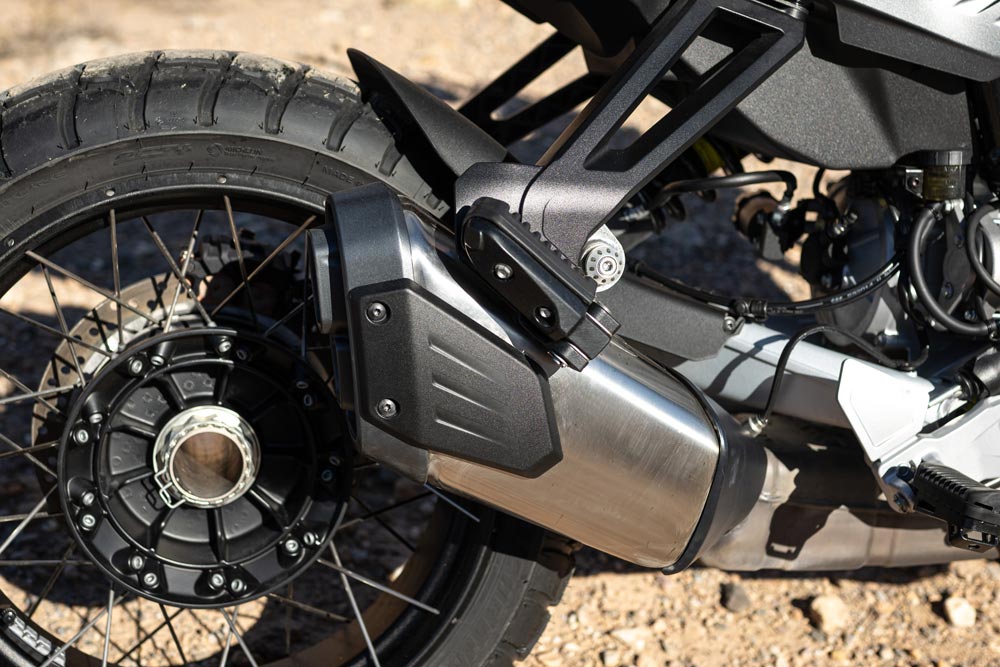 The single-sided spoked wheels look rather classy.
The single-sided spoked wheels look rather classy.
Quickshifter, heated grips and seat, even radar adaptive cruise control are all part of the aftermarket, which is a shame given the demographic the Stelvio is aimed at. The radar cruise control is part of the Aras/PFF Rider Assistance Solution system that includes front and rear radar, front collision warning, lane change assist, and blind spot detection and will cost you an extra $1000 over the purchase price.
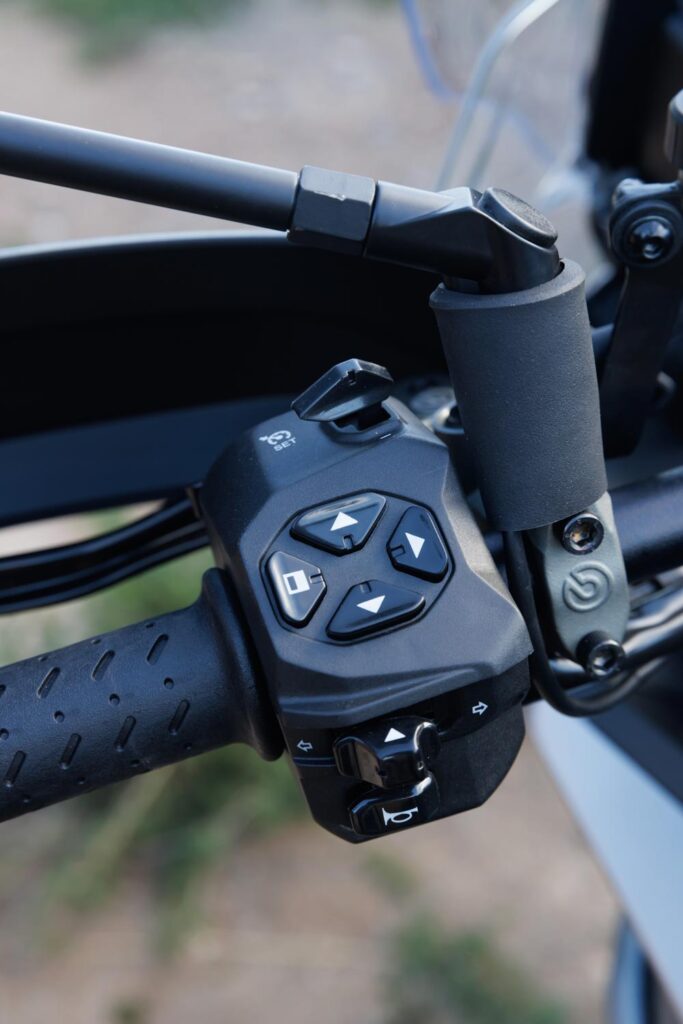 Piaggio still hasn’t really nailed the switch-gear aesthetic.
Piaggio still hasn’t really nailed the switch-gear aesthetic.
In standard form, the Stelvio has front and rear radar and front collision warning via a little light on the dash, and it can be rather annoying when riding in a tight group as the rear collision was flashing at me all the time due to the rider behind. If you’re about to run up the ass of a car, you’ll get a warning light and a little noise from the dash, but I suspect your mind will be on other things. You do get basic cruise control as standard on the Stelvio, but that’s it, and for the best part of $17,000 I’d have expected at least the radar cruise to be standard.
Back to the ride.
The Stelvio is a tall steed with a seat height of 32.68 inches, which puts it smack in the middle of the category (almost all the bikes in this segment are between 32- and 33-inch seat heights). The screen is remote/button controlled, and—praise be whoever you praise—it actually works! It sits at an angle that doesn’t make my helmet buffet too much at 90 mph and doesn’t look like a barn door strapped to the front of the chassis. Well done, Moto Guzzi!
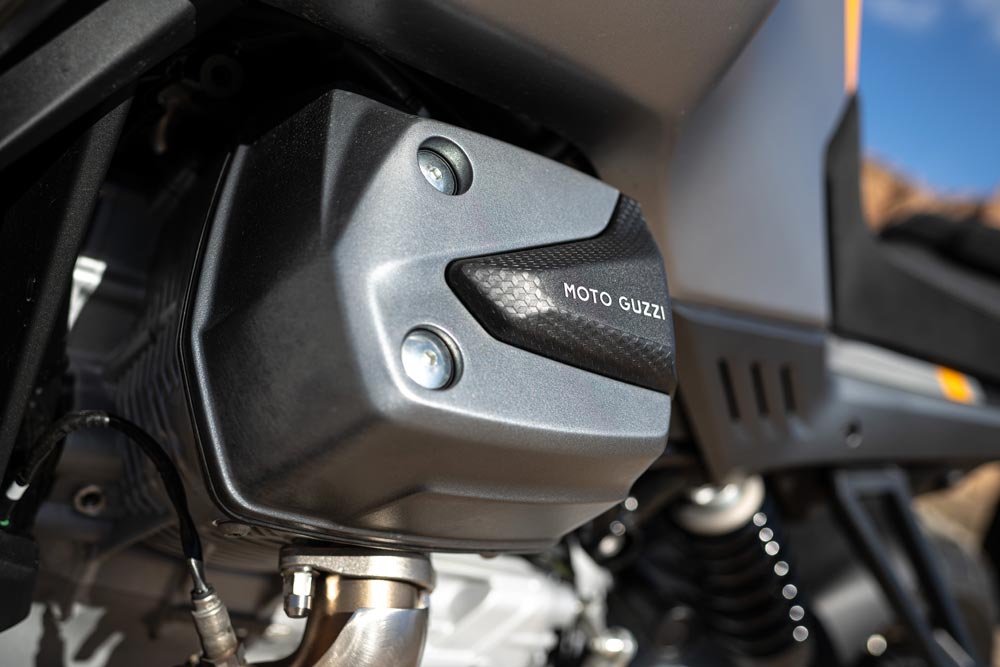 The transverse V-twin is a Moto Guzzi trademark.
The transverse V-twin is a Moto Guzzi trademark.
The suspension is basic in terms of adjustment—preload and rebound damping in the shock and the chunky 46mm fork—but the ride quality is well sorted. The Stelvio isn’t the fastest steering tall bike out there, but it’s plenty of confidence inspiring. You can scratch along at a decent clip without worrying about decking the footpegs, but push it too far, and the front will begin to wander in the middle of the corner, which can be a little unsettling.
Brembo takes care of the braking via its four-piston monoblock calipers and rather high-spec master-cylinder, which gives a great feel at the lever matched to more than enough braking performance. The Stelvio runs Cornering ABS as standard (thankfully, this is not an extra you need to shell out for), so there’s an extra safety level in your pocket there.
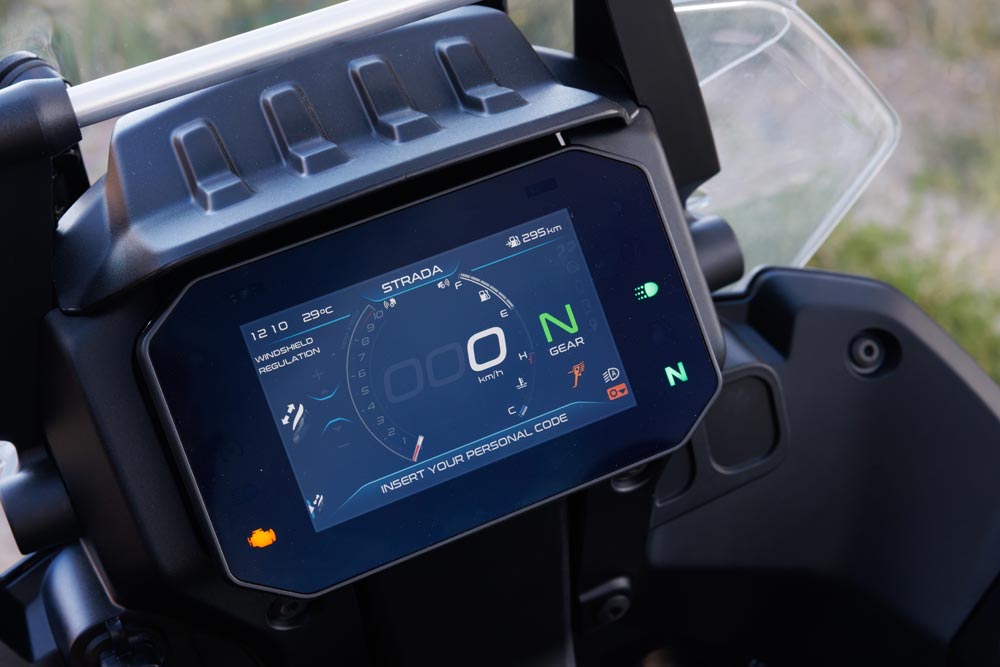 The five-inch dash does the job well enough but isn’t overly flashy like on a Ducati.
The five-inch dash does the job well enough but isn’t overly flashy like on a Ducati.
Our dirt riding on the Stelvio launch was limited to just the area where we took the photos so I can only comment slightly on its dirt prowess. Honestly, it feels like most other large on-road/ADV bikes out there. It’s a little top-heavy but, overall, not too difficult to ride in silty topsoil, although the road-specific Michelin Anakee rubber didn’t really help matters. I’ll reserve off-road judgment until a more thorough ride is completed.
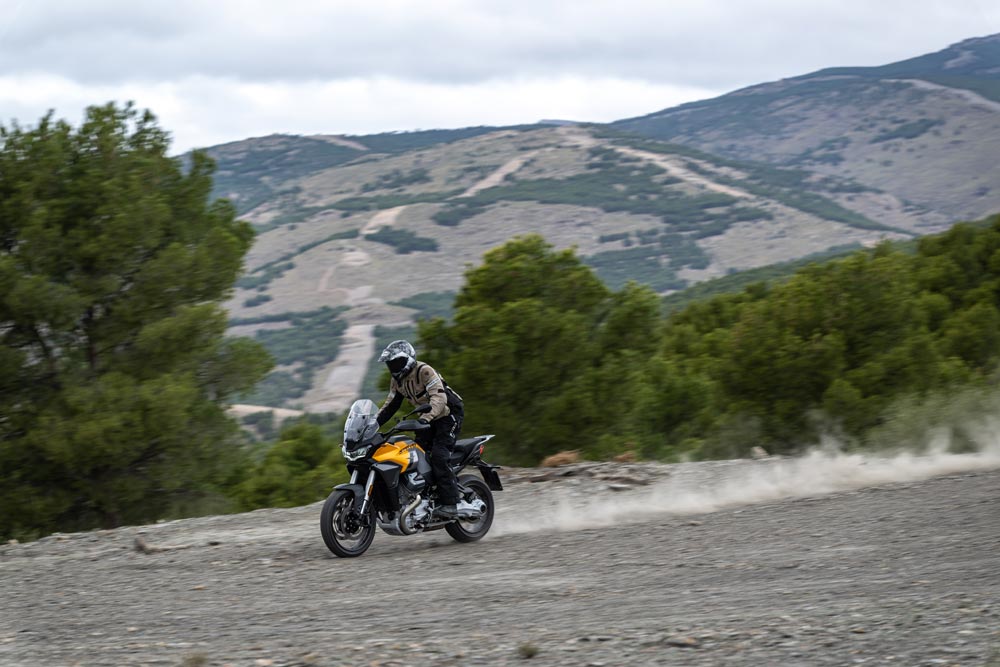 Our ride on the dirt was very short and sweet. The Stelvio handled fine, like a big ADV, but further testing is required.
Our ride on the dirt was very short and sweet. The Stelvio handled fine, like a big ADV, but further testing is required.
If you’re planning on putting a Stelvio in your garage, that trip to the aftermarket catalog is a must, not only for the various electronic add-ons you can get but also for the luggage. MG has developed integrated mounts for the 29- and 30-liter accessory side cases, plus there’s a 37- or 52-liter top box, so you can really load up and head West if you want. There’s also a USB socket as standard fitment.
The Stelvio walks back onto the market against some pretty stiff competition—Ducati Multistrada V2, Triumph Tiger 900, Honda Africa Twin, Suzuki V-Strom 1050, for example—but none of the aforementioned models can lay claim to the pure lust a Moto Guzzi can inspire.
There’s something about that funny-mounted engine that has captivated riders for generations, but it’s nice to see that Stelvio is a serious contender against some of its European counterparts and against those from Japan.
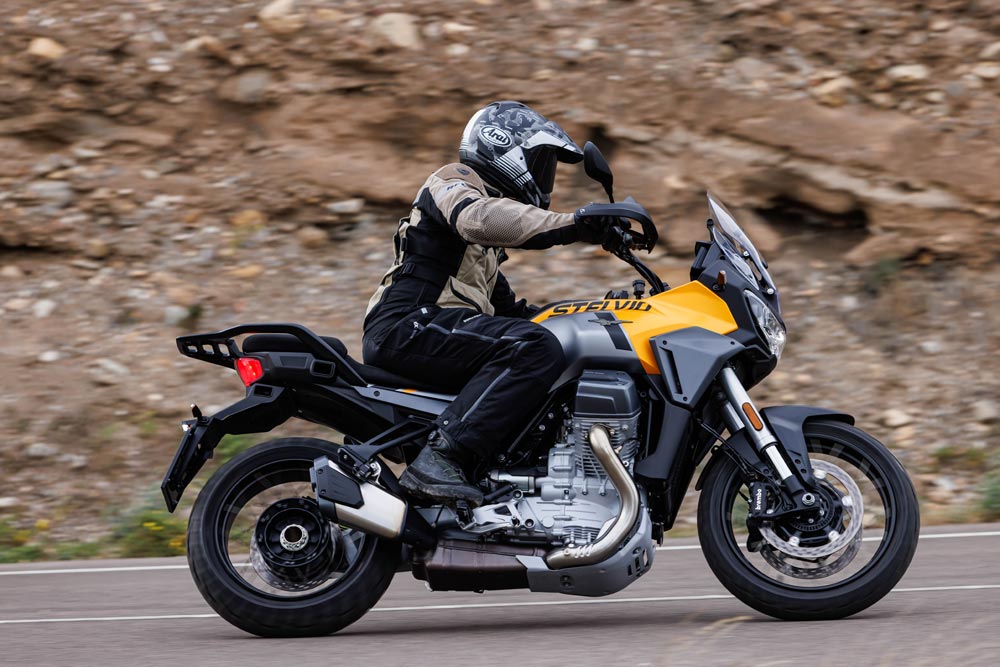 Rennie’s 6’2” frame fits almost perfectly within the Stelvio confines.
Rennie’s 6’2” frame fits almost perfectly within the Stelvio confines.
The Stelvio is a very good machine indeed, although it can leave you a little cold given very little of the tech that is for many of its competitors’ standard fitment, is something you need to pay extra for.
Thems the breaks, as they say, it’s a good thing the ride is such a nice one on the revamped Stelvio. CN
VIDEO | 2024 Moto Guzzi Stelvio First Ride
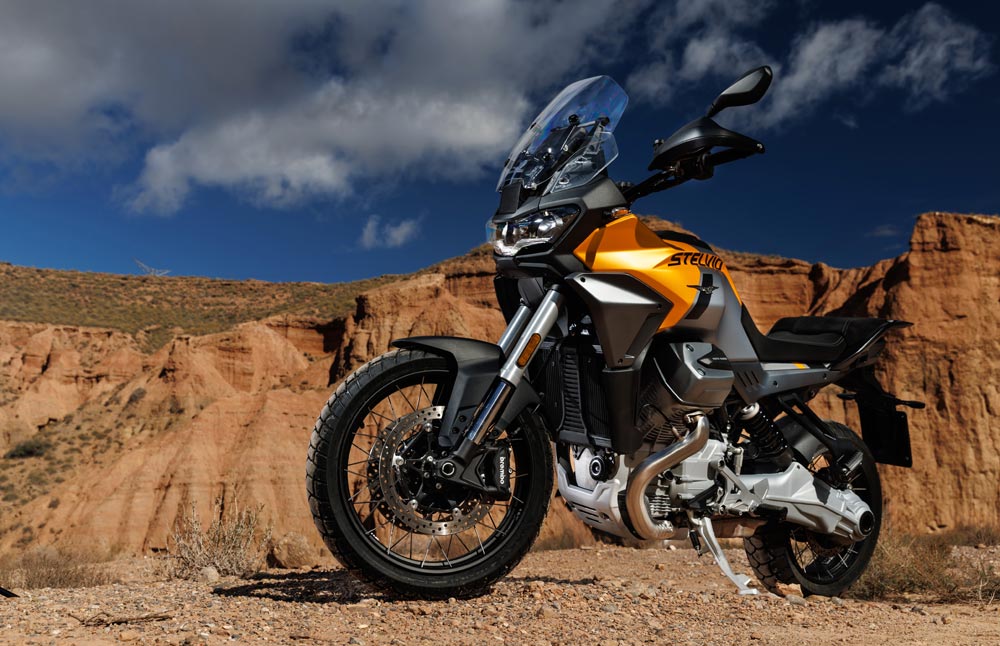
2024 Moto Guzzi Stelvio Specifications
| MSiRP: |
$17,490 |
| Engine: |
Transversal 90° V-Twin, |
| Valvetrain: |
4 valves per cylinder |
| Cooling system: |
Liquid |
| Displacement: |
1042cc |
| Bore x stroke: |
96 x 72mm |
| Compression ratio: |
12.6:1 |
| Fuel system: |
Electronic fuel injection system, 52mm throttle bodies with ride-by-wire system |
| Exhaust: |
2/2/2001 |
| Transmission: |
6-speed |
| Electronics: |
Five Riding Modes, Engine Brake Control, optional Quick Shift up/down, cruise control, full LED lighting system with Cornering lights, electronically adjustable windscreen, five-inch TFT dash, TPMS, optional heated hand grips, optional PFF Rider Assistance Solution system, Moto Guzzi MIA Bluetooth connectivity. |
| Chassis: |
Tubular steel |
| Front suspension: |
46mm Sachs fork, preload and rebound adjustable |
| Rear suspension: |
Sachs monoshock, preload and rebound adjustable |
| Front-wheel travel: |
6.7 in. |
| Rear-wheel travel: |
6.7 in. |
| Front brake: |
Dual Brembo four-piston calipers, 320mm discs, cornering ABS |
| Rear brake: |
Brembo 2-piston caliper, 280mm disc, cornering ABS |
| Front tire: |
120/70R19 in. |
| Rear tire: |
170/60R17 in. |
| Rake: |
25.6° |
| Trail: |
4.58 in. |
| Wheelbase: |
59.8 in. |
| Seat height: |
32.7 in. |
| Fuel capacity: |
5.5 gal. |
| Weight (curb, claimed): |
542 lbs. |
